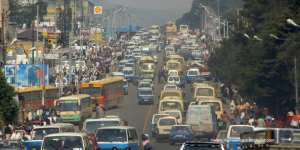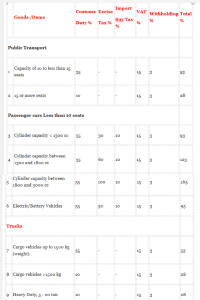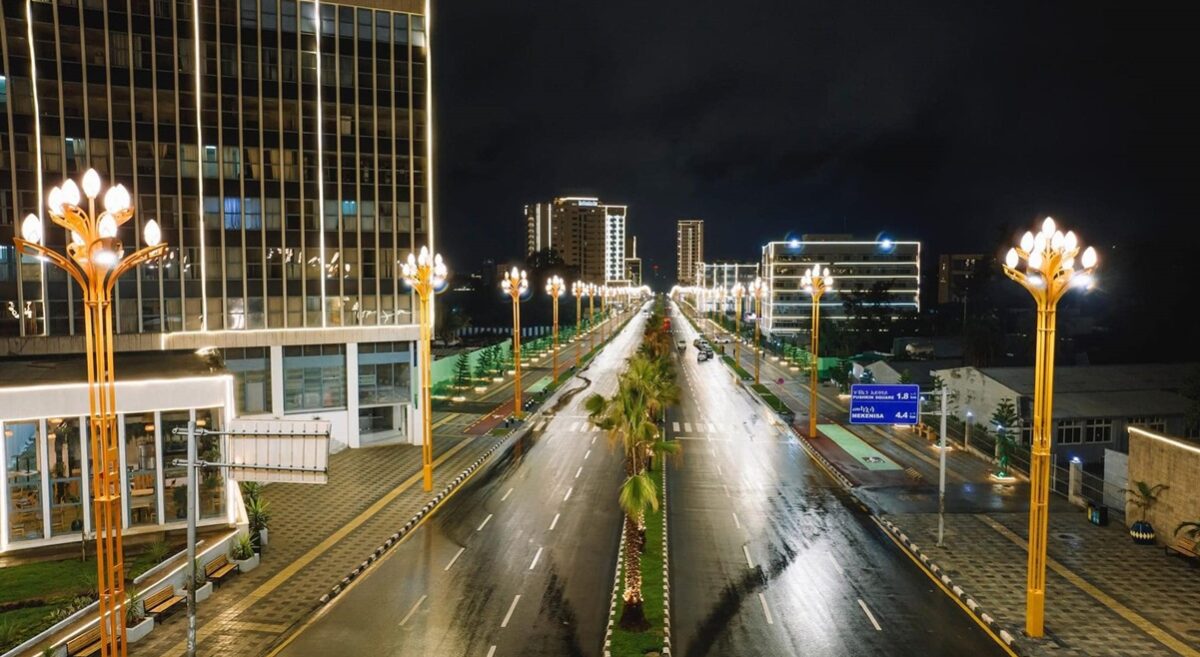Economic commentary: What Ethiopians need is mobility, not automobility. A rejoinder on punitive import tax for cars
Mulugeta Getu Sisay, For Addis Standard
Addis Abeba, August 24/2018 -I recently read an article by Ayele Gelan (PhD), who authored an excellent but also provocative economic commentary which was published on Addis Standard last month. I could not resist my impulses and decided to write my perspective on automobile ownership in Ethiopia. I have no contention with many of the issues raised in Ayele’s article; in fact I concur with handful of them, inter alia, the tax system that covertly incentivize used cars, road carnage, environmental and economic impact of used cars. However, I want to reflect on the very tenant of the commentary that calls for increased automobility and motorization in Ethiopia.
The previous author has presumed many things among which is that automobiles (private vehicles) are essentially desirable and Ethiopians deserve to be unleashed to have one. But why do we need private vehicles? Should current public policy in Ethiopia encourage automobility? What would we get and lose from automobility? It is true that anyone with an interest to enjoy automobility would feel irritated by the current car prices which is unjustly prohibitive of the right to own or drive one’s own car. It is my intention to show, however, that vehicle taxation should be considered from broader economic, social and environmental perspectives and implications than cultural experiences alone. First on the two widely mentioned justifications of automobility: socio-economic benefits and human autonomy.
Socio-economic benefit
Passenger vehicles are primarily used for transporting people from A to B. That would allow people to enhance mobility so that citizens could go to work, market, school, social and family events, and enable one to access essential social services, without which life can’t run its course. That would mean speedy medical attention to the needy, more kids and teens at school, free and speedy movement of labor, spend less time on the road and more on productive works, among other elementary explanations.
Car’s role in the formation and as manifestation of capitalism is well celebrated and uncontested. Motorization is often positively related with growth in income and wealth accumulation. It is indeed a catalyst for economic growth by enhancing productivity and consumption. In the post 1920s-30s Great Depression, Germany used what’s known as ‘motorization’ (Motorisierung) policy to stimulate the national economy, elevate standard of living and also legitimatize Hitle’s reign of terror. He commissioned an inexpensive and economic ‘people’s car’ project that brought ‘Volkswagen Beetle’ (a.k.a Volks in Ethiopia) to the German market. The automotive sector had continued to contribute immensely for Germany’s post-WWII recovery, and other affordable bubble cars like BMW Isetta became very popular both in Germany and beyond.
Ethiopia’s automotive industry is in its infant stage; insignificant in its local market share and contributes too little to the local economy such as employment, tax return, and knowledge transfer. Auto dealers dominate the sector with few assembly facilities either as subsidiary to foreign factories or in a form of joint venture. Hence, tax reduction on cars won’t make local manufacturers any better unless supplemented with differential treatments.
Although it looks that motorization is mostly argued from accessibility and economic utility perspectives, the ‘autonomy’ and ‘car culture’ justifications, often subtle in many discourses, can’t be ruled out.
Autonomy and car culture
This seems to be a normative justification for automobility or motorization. There are some experts (notably politicians and psychologists) who argue that automobility is an extension of ‘human autonomy’ which is inherent in humanity and intertwined with the nature of democracy and freedom. In effect, ‘automobility’ is portrayed as an extension of ‘autonomy’ – ‘autonomous’ + ‘mobility’. Ability to move freely, unconstrained by space and time, attempt omnipresence, free mind set from barriers, and defy limitation to unleash ones desire and potential.
James Dunn (in his book ‘Driving Force’ (1998) presented car as a natural and inevitable outcome of human desire and impulses; it is about freedom, progress and democracy. Some like Lomasky in his ‘Autonomy and Automobility’ book (1997) trace ‘autonomy’ argument back to Aristotle’s conception of ‘movement’ where the ‘self-mover’ human being is separated from the rest and placed high-up in the hierarchy of organisms. However, Matthew Paterson in his book titled ‘Automobile Politics’ (2007) meticulously refuted both arguments. These are widely contestable especially in the digital world where one can virtually present oneself anywhere in the world, order online delivery, click video talk etc.
Car obsession
Certainly, the growing trend of individualism and its manifestation, i.e. ‘movement’, is holding ground in Ethiopia too. But to me, more worrisome than ‘individualism’ and desire of ‘autonomy’ is the growing phenomena of car obsession. For many countries in the developing world, like Ethiopia, vehicles are used to display status and power. Certainly, the single most determinant of vehicle ownership in Ethiopia is income. One who drives luxury passenger vehicle, often less fuel efficient and expensive, considers it as a show off than utility goods.
The associated cultural (social) value to car brands and size are manifestation of current car obsession trend. The mockery, stigma and ‘feminization’ of different fuel efficient light-duty vehicles (LDV) like Atos (Hyundai) and Vitz (Toyota) brands sum up the growing culture of obsession for size. Besides only car culture would best explain why most Ethiopian government officials are captivated by the luxury and extravagant, by public money-for-value parameter, Toyota’s V8 and Prado brands are needed for urban mobility.
In the current meager public transport system of Ethiopia, I am reluctant to argue that the demand for private vehicle is for show off purpose alone. But one can’t rule out the affluence purchases of bigger and heavier – often expensive and less fuel efficient – vehicles. Certainly, the entertainment world – music, cinema and digital games – has contributed its share to the augmentation of such car culture. Still for many Ethiopian’s car is only a means to move from A to B, and not yet assimilated with our material world. It’s not yet an inseparable from our imagination as a house is for many residents, or an ox is for a farmer or camel for a pastoralist. Perhaps in Ethiopia life is still imaginable without a space in the driving seat.
For myriad of reasons that I’ll elaborate on later, driving should not be taken for granted as social good. Ironically, when we jump into the driver’s seat, we often forget its external social cost. As the current market forces are ill-equipped to redress the social costs of driving, public policy measures ought to balance the private experience and comfort of driving and public concern of its externalities – traffic accident, air pollution and emission, congestion land use sprawl and ecological degradation.
What I argue against is inadvertent motorization and not directly about the price of vehicles. Slashing vehicle price without other policy measures to control its perverse impacts would not guarantee the speed, freedom, autonomy and accessibility that vehicles promise to earn us. According to Ethiopian Carbon Resilient Green Economy (CRGE) document, in business as usual scenario, Ethiopian vehicle stock is growing at 15% per annum, and expected to increase by seven fold in 2030 (from about 320,000 in 2010 to 2.3 million in 2030) where more than half of these would be passenger vehicles. My argument revolves around the assumption that slashing the tax rate alone might trigger proliferation of passenger vehicles, and aggravate the already crippled transportation system, economy and socio-environmental injustices. Follow me through the next sections to show that.
Fuel economy
Ethiopian annual foreign currency demand is estimated to be around USD 21 billion but only able to produce about USD 6 billion (NBE and WB). However, National Bank of Ethiopia (NBE) reported that the country has imported goods worth USD 15.8 billion in 2016/17 FY alone. With over 100+ million population and most of industrial products imported, Ethiopian foreign currency demand is nowhere close to what our agriculture oriented exportation and remittance could generate. Currently, fuel import has consumed around USD 1.8 billion (or 11.5% of the total merchandize import) from the already constrained currency. It will continue to rise unabated. The prospect of local biofuel production, itself marred with the long overdue of sugar factories’ construction and failure of biodiesel production, has yet to impress the system. Nor should we stretch our hands unto God until the local production of oil starts.
Hence, reducing vehicle population growth, along with reducing travel demand and improving vehicle fuel efficiency are the three major strategies for reducing overall fuel demand. Yet again, Ethiopia did not craft enough policy instrument and frameworks to execute these strategies. Not sure if it was intended to achieve this, but higher tax rate has restricted the number of vehicles on the road, and hence achieved public good albeit the toughest way.
Road expenditure and debt
Increase in vehicle population inevitably demands more infrastructure construction. True that road development essentially requires a huge capital investment, and Ethiopia was not shy of that too. Ethiopian Road Authority (ERA) recently reported that cash spent for the implementation of the road programs over 19 years (1997 to 2016) reached USD 17.4 billion where 81% came from internal sources and 19% from international community. To put it in a context, in 2013/14 fiscal year Ethiopia dedicated 3.7% of its GDP, which makes about 20% of its total annual and 33% of its annual capital budget, to road sector. World Bank’s ‘Ethiopia Public Expenditure Review 2015’ report show that compared to its education and health sectors expenditure, which sat at about 4% and 1.3% of the GDP respectively in the same year, road investment is being heavy invested in. The trends also show that expenditures in absolute terms are expanding.
A significant amount of road finance also comes from foreign sources in the forms of grant, loan and technical assistance. Anecdotally, concerns are growing about Ethiopia’s foreign debt, paying capacity and sustainability of such aggressive public spending over the years. NBE reported that in 2016/17 FY Ethiopia’s external debt stock has reached a staggering USD 23.5 billion (roughly about 33.6% of the GDP), depicting a 9.2% increase from previous year (NBE, 2016/17 Annual Report). Ethiopia’s growing debt and weak export performance has forced IMF to raise Ethiopia’s risk of external debt distress from “low” to “moderate” in 2015. Many witnessed when even the members of the often uncritical national parliament raised their eyebrows while deliberating on loan agreements. Note also that, in the 2018/19 FY alone, the country dedicated about ETB 22 billion for settlement of its debts.
IMF and WB reported that many of these foreign loans are used for infrastructure development, transport being only second to energy sector. For instance, some estimate that China’s share had risen to more than half of Ethiopia’s total foreign debt, and transport sector takes a third of it. It will not be too far to hear that China will start to reconsider its concessional loans opened up to Ethiopia. If we keep on unpacking the loan mystery further, we could see the staggering amount of money invested on road infrastructure. My point here is obvious. We just cannot continue splashing that much (let alone more) money on road construction even if we want. Certainly, uncontrolled number of vehicles without the mighty of good infrastructure would trigger social crisis.
Traffic congestion
Perverse effects of motorization include traffic accident and congestion, which is destined to escalate in the foreseeable future. We have witnessed the road carnage in Ethiopia that disproportionately affects passengers and pedestrians more than drivers and car owners. Even if the jam is not yet as bad as Nairobi, Addis Abeba has demonstrated its ability to get you trapped in the traffics especially during rush hours, and most hours in central areas. How long will it take to drive from Mexico to Megenagna interfaces or from Piassa to Saris? Arguably, the promised virtuous of automobility – speed, freedom and autonomy of movement – are all vanished with adverse traffic congestion. Is not it the broken promises of the automobile?
Some might argue that the congestion in Addis Abeba is due to poor infrastructure than higher rate of vehicles per person. True!! Yet about 65% of the vehicles in Ethiopia are driven in the streets of the capital. We will then be trapped into the vicious circle of road construction and managing vehicle population, or the ‘cart before the horse’ dilemma. Arguably, the possible solution for me is limiting the number of vehicles in the streets proportionate with our infrastructure capacity. Furthermore, road expansion in Addis is going to expel more residences from their socio-economic base unless we invest in the unthinkable flyover road or tube system.
Experiences tell us that even cities with advanced economies and infrastructure have struggled to provide and fulfil road infrastructure demands. For instance, South-east Asian metropolises with highly advanced road infrastructure like Beijing, Shanghai and Singapore have adopted car ownership restrictions to maintain growth of vehicle population proportionate to their infrastructure, and thereby contain adverse effect of traffic congestion.
Pollution and climate change
Pollution, both local air pollution and emission of greenhouse gasses, from vehicles has been an issue for us and future generation to respond to. One can easily observe the tailpipe black soot built up on the left edges of road divisions across the capital. It is well documented that indoor air pollution from fossil use and tailpipe emission from old and used vehicles, especially in Addis, are the two most alarming air quality setbacks of the country.
According to IPCC about 14% of global greenhouse gas emission are emitted from the transport sector where road takes about two-third of it. It might appear that the share of transport emission in Ethiopia was very little, only 3% in 2010, but is destined to grow to 20% in 2030 (from 5 to 30 million tonnes of carbon dioxide equivalent (Mt CO2e)). If Ethiopia opts to pursue motorization and automobility instead of investing in green transport system now, it will be more onerous to turn back to sustainability later. Hence, I fear that any inadvertent change in the taxation scheme or economic stimulation on vehicle would accelerate acquisition of vehicles, and hence endanger country’s green economy initiatives (zero net emission by 2030) and its commitment to global climate frameworks.
Even with the current policy sphere, in the absence of any policy intervention on vehicle quality, fuel economy and air quality standards, the pollution and carbon emissions are posed to continue unabated. Some argue that the hiking price of new vehicles over used ones – due partly to the flat rate taxation of vehicles irrespective of their fuel efficiency and age – aggravated the tragedy. Yet I argue that differentiated treatment of new and used car that would subject used cars to a higher tax rate could reverse the fault.
Does the current tax system do any justice?
Certainly, the high rate of vehicle tax has limited the number of vehicles on the streets. True that in Ethiopia passenger vehicles are about twice the price in Kenya or thrice the price at the place of origin. This, however, does not necessary mean that Ethiopia imposes 300%+ vehicle tax rates. As depicted in the table below, the rate will only go as high as 163% in the worst case scenario (for a passenger vehicle with cylinder capacity between 1800 and 3000 cc).
Some caveat is needed here. There are additional factors that contribute to the soaring price of vehicles in Ethiopia. Primarily, the base of computation is the purchase price at the place of origin plus the cost of freight and insurance, as estimated by the ERCA authorities (available in a pre-prepared CD). Moreover, the unregulated profit margin of Ethiopian car dealers and lump sum (one off) payment of all vehicle taxes and charges should not be underestimated. In countries where government carry-forward taxes on vehicles, and financial institutions facilitate mortgage or loans, the initial investment on cars seems comparably low but subsumed later in the vehicle’s life time expenses.
Fig. Custom Duties and Taxes on Vehicles
Source: Addis Abeba Institute of Technology (AAIT), Global Fuel Initiative Study of Ethiopia, 2012
Perhaps, the higher tax rate has also minimized the possibility of scrapping as buying new brand becomes super expensive and unaffordable or unprofitable for many. This is one of the failure stories of our transport policies than taxation alone which should have been tackled through other policy measures including fuel economy standards, vehicle quality standards, vehicle age limitation both during importation and on the streets, scrapping incentive schemes, establishing low emission zone (LEZ) etc.
Green transport policy
Transport policies need to balance the competing interests of motorization with country’s resource and capacity to provide equitable means of mobility. Unregulated proliferation of vehicle population would not enhance mobility at all but create transport mess. I argue that there are opportunities for leapfrogging in our transportation system and exploit the virtuous of late comers. Others who once advocated for motorization have been locked-in its perverse effect, and started shifting to public and non-motorized transportation.
Ethiopian transport policy is in the limbo. To the best of my knowledge, the country doesn’t author comprehensive transport policy yet. One finds policies spread across a large spectrum of government documents where the Carbon Resilient Green Economy (CRGE) Strategy is the most recent one though far from being comprehensive. The green transport pyramid (depicted below) known to the world is not overt in Ethiopia. One might witness attempts being made to expand public transportation but never enough to satisfy the desires of its citizens. Besides, except infrastructure development, little has been done in the policy space to lift up the green transportation deficit in the urban life.
Fig. Green transport pyramid
Source: Bicycle Innovation Lab, Copenhagen
No doubt that public policy should consider the social and economic justifications of owing private vehicle, and support its attainment. However, mainstream discourses in transport policy and system should primarily focus on the top four modes in the pyramid – walking, cycling, mass transport and taxi. In Addis Abeba those who walk or bike – often due to inability to afford private vehicle or access public transport – bear the disproportional obligation of risking their life, dignity and security. Equity and public safety are in the limbo when it is noted that 88.4% of roads in Addis Abeba, where walking covers 60% of daily trips, don’t have pedestrian footpaths. Hence, no meaningful attempt was done to support non-motorized transportation in the country. The mess in the bus, light train and taxi transport got worsened over the days. They’re of course being replicated in other big regional cities of Ethiopia as well, especially during the rush hours. AS
Editor’s Note: Mulugeta Getu Sisay is a PhD student at Cardiff School of Law and Politics, Cardiff University. He can be reached at SisayM@cardiff.ac.uk. He tweets at @MulugetaGSisay







